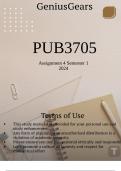PUB3705
Assignment 4 Semester 1
2024
,Introduction
Budget logic in the public sector is a multifaceted process that involves strategic planning, needs
assessment, cost-benefit analysis, sustainability considerations, and transparency and
accountability measures. In this context, the effective allocation of resources is crucial for
government agencies to achieve their organizational goals and deliver essential services to the
public. By applying principles of budget logic, public sector departments can make informed
decisions about resource allocation, prioritize initiatives that address pressing societal needs, an
ensure the efficient and effective use of taxpayer funds. This introduction provides an overview o
the five key aspects of budget logic and their application to a specific public sector department,
highlighting the importance of strategic prioritization, needs assessment, cost-effectiveness,
sustainability, and transparency in budgetary decision-making.
,Discuss five (5) aspects of budget logic in detail and apply it to a public sector
department of your choice
Strategic Priorities:
Budget logic starts with identifying and aligning with strategic priorities. For the Department of Education
●
this could involve goals such as improving literacy rates, increasing access to quality education, and
enhancing teacher training.
●
The budget should allocate funds to initiatives that directly support these priorities. For instance, investin
in reading programs, expanding educational resources in underserved areas, and providing professiona
development opportunities for teachers.
Needs Assessment:
Conducting a thorough needs assessment is crucial. This involves evaluating current resources,
●
identifying gaps, and anticipating future demands.
●
In the context of the Department of Education, this might mean analyzing student demographics,
assessing the condition of school facilities, and evaluating the effectiveness of existing educational
programs.
●
The budget should address these needs by allocating resources accordingly. For example, if there's a
shortage of qualified teachers in certain regions, funds might be allocated for recruitment efforts or
incentives to attract educators to those areas.
Cost-Benefit Analysis:
Budget decisions should be informed by cost-benefit analysis to ensure the most efficient use of
●
resources. This involves weighing the costs of various initiatives against their potential benefits.
●
In the Department of Education, this could mean evaluating the impact of different interventions on
student outcomes. For example, investing in early childhood education programs may have long-term
benefits in terms of improved academic performance and reduced dropout rates.
●
The budget should prioritize investments that offer the greatest return on investment in terms of
educational outcomes.
Sustainability:
Budget logic requires consideration of long-term sustainability. This involves not only ensuring that curre
●
needs are met but also planning for future challenges and opportunities.
●
For the Department of Education, sustainability might involve investing in infrastructure upgrades that
reduce long-term maintenance costs or implementing policies that promote environmental sustainability
within schools.
●
The budget should allocate resources in a way that balances immediate needs with long-term
sustainability goals.
Transparency and Accountability:
●
Budget decisions should be transparent and subject to public scrutiny. This helps build trust and
accountability.
●
In the public sector, including the Department of Education, transparency might involve publishing
detailed budgetary information, soliciting input from stakeholders, and conducting regular audits to ensur
funds are being used appropriately.
●
The budget should reflect a commitment to accountability by clearly articulating how funds are being
allocated and demonstrating the impact of expenditures on educational outcomes.




